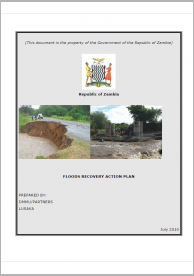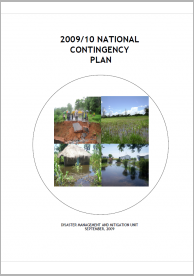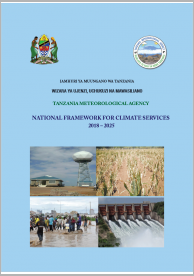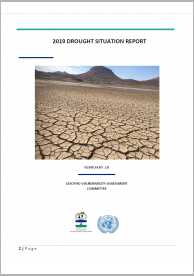
Recovery Action Plan with specific activities and costing that result from the proposed recommendations in the 2009/2010 In-Depth Vulnerability and Needs Assessment Report that was undertaken in 17 districts.
The following is a list of all conten labeled as "Water"

Recovery Action Plan with specific activities and costing that result from the proposed recommendations in the 2009/2010 In-Depth Vulnerability and Needs Assessment Report that was undertaken in 17 districts.

This contingency plan covers the 2009-2010 rainy season with the likely scenario of having floods as a hazard. This scenario is based on the 2009-2010 rainfall forecast for the country obtained from the Zambia Meteorological Department (ZMD). It anticipates that a total population of 713,193 people (118,866 households) residing in 43 districts are likely be affected by floods.

The INDCs are guided by the principles of the United Nations Framework Convention on Climate Change, and when identified will:

This National Framework for Climate Services underline the necessity of increased political support and institutional collaborations, the urgent need for enhanced weather and climate services delivery to end users, improved access to weather and climate services for agriculture (crop production and animal husbandry), health, and water resources sectors; and disaster risk reduction.

The ACRP will serve as a roadmap for mainstreaming climate change within current agricultural policies, plans, and practices, as well as identifying gaps were new investments may be needed. It will be the guiding framework for a more comprehensive and consistent approach for confronting one of the major risks to current crop productivity and future investments.

Lesotho experienced drought from the start of the winter season up to date. The results of which is felt across the whole country whereby most of the districts reported water shortages for both human and livestock consumption. Water levels in many water bodies and underground water have been deteriorating since 2012 and this has negative impacts on different sectors.

The main objective was to analyse food and nutrition security, and vulnerability of the population of Lesotho in 2019/2020 consumption year. Provide policy makers, government and other stakeholders with information for decision making and development programming.

The Seychelles Sustainable Development Strategy (SSDS) 2012-2020 is an approved national instrument which incorporates national priorities for sustainable development and lays out a roadmap for the implementation of those priorities.

The Seychelles Sustainable Development Strategy (SSDS) 2012-2020 is an approved national instrument which incorporates national priorities for sustainable development and lays out a roadmap for the implementation of those priorities.

The NCCS will provide a coherent and consolidated response to climate change. This strategic document will remain a “working” document intended to be updated and revised on an ongoing basis in response to new challenges and opportunities.